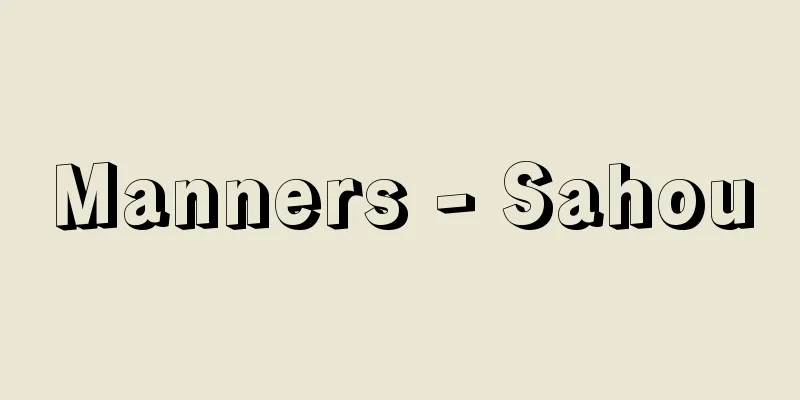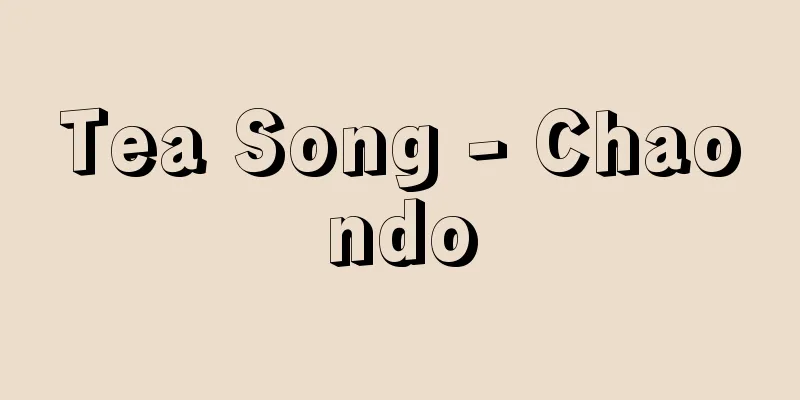Medal - Award

|
A national honor. A badge of honor bestowed by the state to recognize individuals who have made outstanding contributions to the nation or the public good. [Cabinet Office Awards Bureau] historyJapan had a system of awards of honor since before the feudal era, but these were honorary titles and were a different system from medals. The first time an order of Western origin was used in Japan was on the opening day of the 5th World Exposition held in Paris in 1867 (Keio 3), when the Satsuma Domain presented the "Satsuma Ryukyu Order of Honor" to Emperor Napoleon III and other civil and military officials (kept at the Shoko Shuseikan in Kagoshima City and the Kagoshima Prefectural Historical Materials Center Reimeikan). This medal was produced in Paris modeled after the French Légion d'honneur, and features the Shimazu family crest of a cross in a circle in white in the center of a red star, the five characters for Satsuma Ryukyu between the stars, a vermilion ribbon, and the words "presented to civil and military officials" written on the back. This is said to be Japan's first order of honor. Meanwhile, the Edo Shogunate, having seen the achievements of the Satsuma Domain, also felt the need for an order system, and began researching and studying the system and considering its design, but due to the chaos of the Meiji Restoration it was never realized. After the new Meiji government was established, the significance and value of medals became apparent through visits by foreign envoys to Japan and inspection tours by high-ranking government officials abroad, and in 1871 (Meiji 4), the new government consulted with the Left House (legislative body) on the creation of a medal system, and in 1873, it established the Medal Investigation Section to collect information and conduct research, and in 1875, medals of various grades were established. This became the Order of the Rising Sun, which is now awarded from First Class to Eighth Class, and was renamed the Order of the Rising Sun the following year. Then, in 1876, the Grand Order of the Chrysanthemum was established as a title higher than First Class, and the corresponding Grand Cordon of the Order of the Chrysanthemum and the Order of the Chrysanthemum (a secondary medal of the Grand Cordon of the Chrysanthemum) were added. In 1988, following the example of other countries, the Order of the Precious Crown, the Order of the Sacred Treasure, the Grand Cordon of the Order of the Rising Sun and Paulownia Flowers, and the Order of the Chrysanthemum Necklace were added to the system in order to make it easier to operate. In 1990, the Order of the Golden Kite was established with the aim of encouraging loyalty and bravery, but was abolished with the coming into force of the Japanese Constitution in 1947 (Showa 22). In 1937 (Showa 12), the Order of Culture was established to be awarded to those who have made achievements in the fields of academia and the arts. [Cabinet Office Awards Bureau] Grades and TypesThe current Japanese system of awards, excluding the Order of Culture, has the Grand Cordon of the Order of the Chrysanthemum as the highest order, followed by eight orders from First Class to Eighth Class, and medals equivalent to these orders are awarded. This system was modeled on foreign countries, with reference to Japan's old system (orders). The Order of the Chrysanthemum consists of the Grand Cordon of the Order of the Chrysanthemum (highest grade) and the Grand Cordon of the Order of the Chrysanthemum. The Order of the Rising Sun consists of First Class to Eighth Class, with the first class having names such as the Grand Cordon of the Order of the Rising Sun with Paulownia Flowers (the highest grade of the Order of the Rising Sun) and the Grand Cordon of the Order of the Rising Sun, and the second class having names such as the Grand Cordon of the Order of the Rising Sun, Grand Cordon. The Order of the Precious Crown and the Order of the Sacred Treasure also come in First Class to Eighth Class. The Precious Crown is only awarded to women. The Order of Culture is a single-level award with no rank distinction, whereas the Order of the Golden Kite has ranks of merit equivalent to those of other medals, and is divided into seven ranks. [Cabinet Office Awards Bureau] Medal designThe necklace of the Medal of the Chrysanthemum features the character "Meiji," the year of its establishment, written in ancient seal script, and is decorated with chrysanthemum flowers and leaves. The Medal of the Chrysanthemum is surrounded by chrysanthemum flowers and leaves, with a sun symbol in the center. The Medal of the Rising Sun is decorated with a rising sun and paulownia leaves. The Seventh and Eighth Class Orders of the Order are decorated with paulownia flowers and leaves, but do not have a sun symbol. The Medal of the Precious Crown is modeled after the crowns of ancient empresses, with the knobs adorned with paulownia flowers (First Class), peony (Second Class), butterfly (Third Class), wisteria (Fourth Class), apricot (Fifth Class), and ripples (Sixth Class), which were taken from the ceremonial garments of ancient court ladies (Precious Crowns of the Fifth Class and above are studded with pearls). The Order of the Sacred Treasure has a jeweled mirror in the center and rays of light around it, while the Order of Culture features a tachibana (mandarin orange) and a magatama (comma-shaped jewel). [Cabinet Office Awards Bureau] Operation of the decoration systemWhen the Order was first established, it was mainly awarded to those who had distinguished themselves in the Meiji Restoration and the Satsuma Rebellion as a reward for meritorious service, but in 1883 (Meiji 16), the Orders Ordinance was established, which stipulated a certain number of years for those in civil and military positions to receive the Order and the number of years of service required for the Order to be promoted, and opened the way for the Order to be awarded twice a year on a regular basis. Subsequently, in 1886, the Rules for the Award of Orders to the Imperial Family were amended, and in 1888, the Rules for the Award of Orders to Foreigners were amended as a standard for the award of Orders to foreigners, and the Orders Ordinance was amended to include the addition of Orders. Following the major reform of the civil service system in 1892, it became difficult to apply the previous rules, so new Rules for the Award of Orders were established, which, although partially amended, served as the standard for awarding Orders until 1946 (Showa 21). In 1915 (Taisho 4), the twice-yearly awarding of decorations was changed to once a month, and in 1919, a policy was decided on awarding decorations to members of the House of Peers and the House of Representatives, mayors and deputy mayors of cities and towns, in accordance with the internal regulations for awarding decorations. Also in the same year, it was decided that the Order of the Sacred Treasure would be awarded to women who had made distinguished contributions. After the Sino-Japanese War, awards for meritorious service were carried out with the internal regulations for awarding each time. The Order of Culture is, in principle, awarded once a year, which remains the case today. In 1946, due to a fundamental reform of the civil service system, it became difficult to apply the previous internal rules for awarding decorations, and the awarding of decorations to surviving individuals was suspended. Following a natural disaster in 1953, the awarding of decorations to those who needed urgent assistance was partially resumed. In 1988, a Cabinet decision was made to change the previous system of awarding decorations, which had been mainly for civil servants, and to start awarding decorations to surviving individuals who have made distinguished contributions in various fields and at various levels. In April of the following year, 1989, the awarding criteria (internal rules) were established, and the first awarding took place on April 29th. Since then, it has become customary to award decorations on April 29th (Greenery Day) in the spring and on November 3rd (Culture Day) in the fall. As of spring 1999, a total of 71 awards had been given to approximately 267,000 people. In 1989, a policy was decided on awarding decorations to those who died in World War II, and decorations are now awarded monthly. As of 1999, approximately 2.05 million people have been awarded decorations. [Cabinet Office Awards Bureau] Foreign medalsThe system of medals originated in Western Europe, and originated from the emblem of the religious orders of chivalry that were established in the Holy Land of Jerusalem in the 12th century during the Crusades. Today, the English word for medal is "order" because of this origin. Currently, the medal system is adopted not only in Western Europe but also in other countries around the world, but the names of the orders are mostly derived from the knighthoods. There are generally five orders, and sometimes a necklace as the highest order is placed above them. The five orders are usually in the order of Grand Cross, Grand Officer, Commander, Officer, and Knight. There are also three-order and single-class medals, and some use gold stars, silver stars, etc. to represent the order. For necklaces, the main medal is worn below the throat and the secondary medal on the left side of the chest; for first class medals, the grand ribbon is worn hanging from the right shoulder to the left armpit and the secondary medal is worn on the left side of the chest; for second class medals, the ribbon is worn on the right side of the chest; for third class medals, the middle ribbon is worn below the throat, and for fourth class and below, the small ribbon is worn on the left side of the chest. This is the same for all national medals. In the United Kingdom, there are various awards, including the Order of the Garter (single class), established in 1348, the Order of the Thistle (single class), the Order of the Bath (three classes), the Order of Merit (single class), the Order of St Michael and St George (three classes), the Royal Victorian Order (five classes), and the Order of the British Empire (five classes). In France, the Légion d'honneur (five classes) established by First Consul Napoleon in 1802 still exists, as does the Order of Merit (five classes) established by President de Gaulle in 1963. In addition, there are other awards from each ministry, such as the Order of Arts and Letters (three classes) awarded by the Minister of Culture. Germany has only one national award, the Order of Merit of the Federal Republic of Germany (3 classes, 8th grade), which was established in 1951. The Order of Merit for Science and Art (single class) is an award given by academic and artistic organizations. The United States does not have a system of medals, only a system of insignias. Most of these are military-related, but the main presidential civilian medals are the Medal of Freedom and the National Security Medal, and the main military awards are the Medals of Honor and the Silver Star. In the former Soviet Union, there were many kinds of medals, such as the Order of Lenin and the Order of the Red Banner, but after the collapse of the Soviet Union, the medal system has not been established in present-day Russia. The medals from the Soviet era are used arbitrarily. The Netherlands has the Order of the Lion (3 classes), the Order of Orange-Nassau (6 classes), and the Order of the House of Orange (6 classes). Denmark has the Order of the Elephant, its highest single class, and the Order of the Dannebrog, with 6 classes. Sweden has the Order of the Seraphim, its highest single class, and the Order of the North Star, with 5 classes. Brazil's leading awards are the Order of the Southern Cross, 6th class, and the Order of Rio Branco, 5th class. In South Korea, the Grand Order of Mugunghwa (single class), Grand Order of National Foundation (three classes), Military Merit (five classes), Order of Friendship (five classes), Order of Culture (five classes), and Sports Medal (five classes). Currently, there is no medal system in China. [Protocol Office, Minister's Secretariat, Ministry of Foreign Affairs] "Medals" by Junichi Fujigashi (1972, Hoikusha, Color Books)" ▽ "Medals" edited and published by the Mainichi Newspaper Company (1976)" ▽ "The History of Medals" by Kaoru Naka (1973, Yuzankaku Publishing) [Reference] |Source: Shogakukan Encyclopedia Nipponica About Encyclopedia Nipponica Information | Legend |
|
国の栄典の一つ。国家または社会公共に対して優れた功績をあげた者を表彰するために国から与えられる名誉の標章。 [内閣府賞勲局] 歴史日本においては、封建時代以前から勲位制度もあったが、これは名誉の称号で、勲章とは異なった制度であった。西洋に起源をもつ勲章が日本で活用されたのは、1867年(慶応3)にパリで開催された第5回万国博覧会の開会式当日、薩摩(さつま)藩が皇帝ナポレオン3世をはじめ文武官に贈った「薩摩琉球(りゅうきゅう)国勲章」(鹿児島市の尚古(しょうこ)集成館、鹿児島県歴史資料センター黎明館に保存)である。この勲章は、フランスのレジオン・ドヌール勲章を見本としてパリで製作され、赤い星形の中央に丸に十字の島津家の定紋を白く浮かし、星の間に薩摩琉球国の5字を配し、朱色の綬(じゅ)(リボン)をつけ、裏面に「贈文官兼武官」と記してあり、これが日本最初の勲章といわれている。 一方江戸幕府においても、薩摩藩の成果を見聞することにより、勲章制度の必要を感じ、勲章制度の調査研究を開始して、その図案を検討していたが、維新の混乱で実現されることはなかった。 明治新政府が成立し、外国使臣の訪日、政府高官の外国視察などによって、勲章の意義、価値が認識され、1871年(明治4)新政府は、賞牌(しょうはい)(勲章)制度の審議を左院(立法機関)に諮問して検討を始め、73年に「メダイユ」取調掛(がかり)を置き資料収集、調査研究にあたらせ、75年に勲等賞牌が制定された。これが現在の勲一等から勲八等までの旭日(きょくじつ)章で、翌年に勲章と改称された。ついで76年に、勲一等の上位の称号として大勲位を設け、これに対応する勲章の菊花大綬章および菊花章(菊花大綬章の副章)が増設された。その後88年に、叙勲制度の運用を容易にするため、諸外国の例に倣って、宝冠章、瑞宝(ずいほう)章、旭日桐花(とうか)大綬章および菊花章頸飾(けいしょく)が増設された。90年に忠勇を奨励する趣旨で金鵄(きんし)勲章が創設されたが、1947年(昭和22)の日本国憲法施行とともに廃止された。また1937年(昭和12)に、学術、芸術上の功績者に対して授与される文化勲章が制定された。 [内閣府賞勲局] 等級および種類現行の日本の勲章制度は、文化勲章を除いて、大勲位を最高とし、その下に勲一等から勲八等までの8等級の勲等に区分され、この勲等に相当する勲章が授与される。この制度は、日本の古制(勲位)を参考として外国の例に倣ったものである。菊花章には、大勲位菊花章頸飾(最上級)と大勲位菊花大綬章がある。旭日章には、勲一等から勲八等まであり、勲一等のうちに旭日桐花大綬章(旭日章の最上)と旭日大綬章、勲二等は旭日重光章などのようにそれぞれ名称がつけられている。宝冠章および瑞宝章も、勲一等から勲八等までがある。なお、宝冠章は女性のみに授与される。 文化勲章は、勲等別がなく単一級である。金鵄勲章は、他の勲章の勲等に相当する功級があって、7等級に分けられていた。 [内閣府賞勲局] 勲章のデザイン菊花章の頸飾は、制定年代の「明治」の文字を古篆(こてん)で表し、菊の花と葉をあしらっている。菊花章は、その周囲に菊の花と葉をあしらい、中央は日章をかたどっている。旭日章は、旭日をかたどり、桐の葉をあしらっている。なお、勲七等、勲八等は桐の花と葉をあしらい、日章はない。宝冠章は、古代女帝の宝冠を模し、鈕(ちゅう)(つまみ)の部分に桐(きり)(勲一等)、牡丹(ぼたん)(勲二等)、蝶(ちょう)(勲三等)、藤(ふじ)(勲四等)、杏(あんず)(勲五等)、波紋(勲六等)をかたどっており、これは古代女官の衣紋(えもん)から取り入れた(勲五等以上の宝冠章には真珠がちりばめてある)。瑞宝章は、中央に宝鏡を模し、周囲は光線をかたどっている。文化勲章は、橘(たちばな)と勾玉(まがたま)をあしらっている。 [内閣府賞勲局] 叙勲制度の運用勲章創設当時は、論功行賞として明治維新および西南戦争の勲功者がおもに叙勲されたが、1883年(明治16)に叙勲条例が定められ、一定年限、文武官の官職にある者の叙勲および勲等の進級に要する在職年数が定められるとともに、年2回定期的に叙勲の道が開かれた。その後86年に皇族叙勲内則、また88年に外国人に対する叙勲の標準として外国人叙勲内則、勲章が増設されたことによる叙勲条例の改正があり、92年の官吏制度の大改革に伴って、従前の内規の運用が困難となったため、新たに叙勲内則が定められ、これが1946年(昭和21)までの間、部分的改正はあったが叙勲基準となって運用された。1915年(大正4)に年2回の叙勲を月1回実施することに改め、19年には、叙勲内則に準じて貴族院議員、衆議院議員、市町村長および市町村助役に対する叙勲の方針が決定された。また同年には、女性の功労ある者に瑞宝章が授与されることとなった。日清(にっしん)戦争以後の論功行賞は、そのつど賞賜内規が定められて実施された。文化勲章は、原則として年1回授与され、現在に至っている。 1946年(昭和21)に官吏制度の根本的な改革などのため、従前の叙勲内則の運用が困難となり、生存者に対する叙勲は停止となった。53年の天災を契機に、緊急を要するものについて叙勲が一部開始された。63年に官公吏を中心とした従前の叙勲の運用を改め、各界各層の功労者を対象とする生存者叙勲開始の方針が閣議決定され、翌64年4月に叙勲基準(内規)を定め、4月29日に第1回の叙勲が実施された。以後、春は4月29日(みどりの日)、秋は11月3日(文化の日)に行うことが慣例となり、99年春までに延べ71回、約26万7000人が叙勲されている。なお、64年に第二次世界大戦における戦没者に対する叙勲の方針が決定され、毎月叙勲が実施されて、99年までに約205万人の叙勲が実施されている。 [内閣府賞勲局] 外国の勲章勲章は西ヨーロッパに発祥した制度で、十字軍遠征の際、12世紀、聖地エルサレムに設立された宗教騎士団religious orders of chivalryの標章に由来している。今日、勲章のことを英語で「オーダー(order)」というのはこの由来のためである。現在、勲章制度は西ヨーロッパのみならず世界各国で採用されているが、勲等を表す名称は、おおむね騎士団に由来するものが用いられている。勲等は5階級が一般的で、その上に最高勲章たる頸飾(けいしょく)がくることもある。5階級の勲等は、グランド・クロスgrand cross、グランド・オフィサーgrand officer、コマンダーcommander、オフィサーofficer、ナイトknightの順になっていることが多い。3階級、単級の勲章もあり、勲等を金星、銀星等で表すものもある。 頸飾は、正章をのど下に、副章を左胸に着用し、一等勲章は大綬を右肩から左脇(わき)に下げて正章をつるし、副章を左胸に着用し、二等勲章は右胸に、三等勲章は中綬でのど下に、四等以下の勲章は小綬で左胸に着用する方法が、ほぼ各国勲章に共通している。 イギリスには、1348年に定められたガーター勲章(単級)をはじめ、シッスル勲章(単級)、バース勲章(3階級)、功労勲章(単級)、聖マイケル聖ジョージ勲章(3階級)、王室ビクトリア勲章(5階級)、英帝国勲章(5階級)などがある。 フランスには、ナポレオン第一執政が1802年に制定したレジオン・ドヌール勲章(5階級)が存続しており、ドゴール大統領が1963年に制定した功労勲章(5階級)がある。そのほか各省の勲章の一つとして、文化大臣の芸術文学勲章(3階級)などがある。 ドイツの国家勲章としては、1951年に設けられたドイツ連邦共和国功労勲章(3階級、8等級)のみがある。科学芸術功労勲章(単級)は学術芸術団体の勲章である。 アメリカ合衆国には、勲章制度がなく、記章制度しかない。そのほとんどが軍関係のものであるが、大統領が授与する民間人を対象とするメダルには自由記章および国家安全保障記章があり、軍功勲章では各軍名誉章、同銀星章がおもなものである。 旧ソ連にはレーニン勲章、赤旗勲章など多くの種類の勲章があったが、ソ連崩壊後、現在のロシアでは勲章制度は確立していない。ソ連時代の勲章を恣意的に運用している。 オランダには、獅子勲章(3階級)、オラニエ・ナッソー勲章(6階級)、オラニエ家勲章(6階級)などがある。デンマークには単級の最高勲章である象勲章と、6階級のダンネブロー勲章がある。スウェーデンには、単級の最高勲章であるセラフィム勲章のほか、5階級の北極星勲章がある。 ブラジルの代表的勲章は、6階級の南十字星勲章と、5階級のリオ・ブランコ勲章である。 韓国には無窮花大勲章(単級)、建国大勲章(3階級)、武功勲章(5階級)、修交勲章(5階級)、文化勲章(5階級)、体育勲章(5階級)などがある。 中国には、現在、勲章制度は存在しない。 [外務省大臣官房儀典官室] 『藤樫準二著『勲章』(1972・保育社・カラーブックス)』▽『毎日新聞社編・刊『勲章』(1976)』▽『那珂馨著『勲章の歴史』(1973・雄山閣出版)』 [参照項目] |出典 小学館 日本大百科全書(ニッポニカ)日本大百科全書(ニッポニカ)について 情報 | 凡例 |
<<: Fumigation - Kunjo (English spelling) fumigation
Recommend
He Jin - Kashin
… [The formation and development of the era of se...
Anastasios
…He was appointed Bishop of Constantinople by Emp...
Sea stone
〘 noun 〙 A stone that comes out of the sea. ⇔ Moun...
Sar'yan, MS (English spelling)
…The sea he painted symbolized power, vastness, a...
Iron sulfate
Iron sulfate. Three types are known: (1) Iron(II)...
Eid Frith - Eid Frith
…It measures 34cm x 25cm and has 659 leaves. Acco...
Social welfare fund
...The aim of the law was to unify the legal prov...
Cupra - Kyupura (English spelling) cupra
A type of regenerated cellulose fiber. It is rayo...
Empress - Nyoin
The title given to the mother of an emperor, an e...
Thermotropic liquid crystal
...In contrast, the molecules that make up liquid...
Sadoshima Chogoro
Year of death: July 13, 7th year of the Horeki era...
Latex - latex (English spelling)
It is an emulsion of rubber particles with an ave...
《Akebono Soga Night Attack》 - Akebono Soga Night Attack
... The sword attack and seppuku of Asano Takumi ...
Shahrāzād (English spelling) Shahrazad
…She married King Shahryar, who had become distru...
Hokubo [town] - Hokubo
An old town in Jobo County, central Okayama Prefec...









